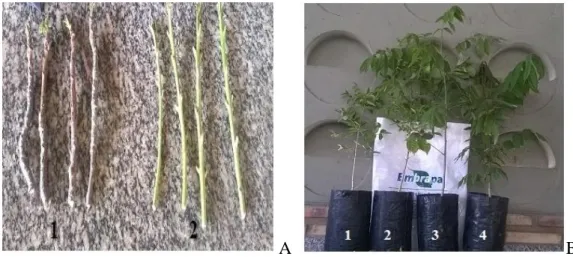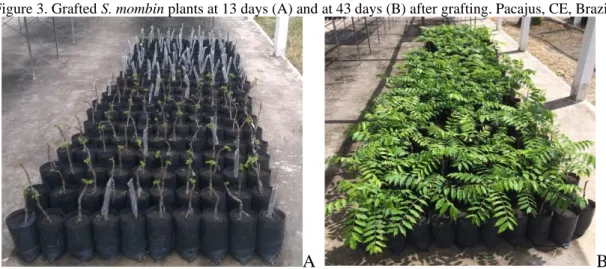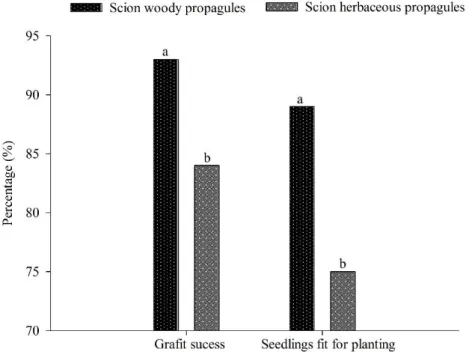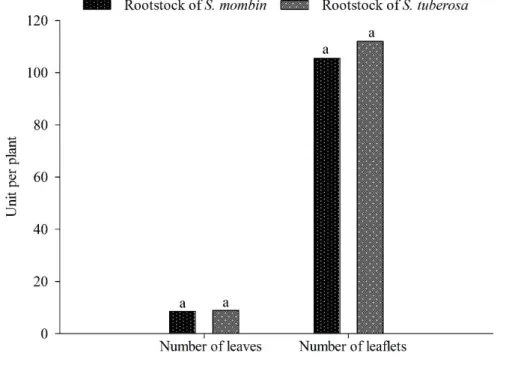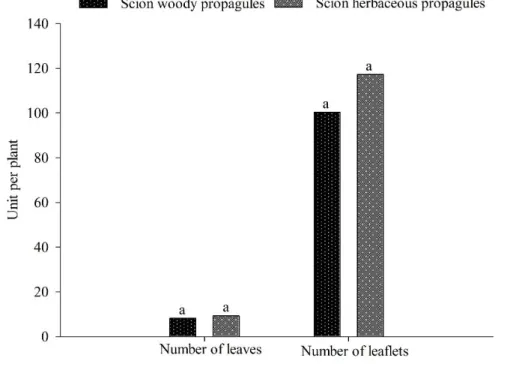Braz. J. of Develop.,Curitiba, v. 6, n. 10, p. 74550-74561 ,oct. 2020. ISSN 2525-8761
Rootstock species and scion types on Spondias mombin seedling formation
Porta-enxerto e tipo de enxerto na formação de mudas de cajazeira
DOI:10.34117/bjdv6n10-035
Recebimento dos originais:08/09/2020 Aceitação para publicação:02/10/2020
Nouglas Veloso Barbosa Mendes
Mestre em Agronomia-Fitotecnia pela Universidade Federal do Ceará Instituição: Agritech Semiárido Agricultura Ltda
Endereço: Rua Cel. José Freire, 77, Centro, 63460-000, Pereiro, CE, Brasil E-mail: nouglasmendes@hotmail.com
Francisco Xavier de Souza
Doutor em Agronomia-Fitotecnia pela Universidade Federal do Ceará Instituição: Embrapa Agroindústria Tropical
Endereço: Rua Dra. Sara Mesquita, 2.270, Planalto do Pici, 60511-110, Fortaleza, CE, Brasil E-mail: xavier.souza@embrapa.br
ABSTRACT
The objective of this work was to evaluate the effect of rootstock species and scion types on the graft success and seedling formation of Spondias mombin plants. The experiment was conducted in a completely randomized design, with a 2×2 factorial arrangement, consisted of 2 scion types (woody, from the plant apex; and herbaceous, from regrowth structures of pruned branches) and 2 ungrafted rootstock species (S. mombin and S. tuberosa), with 5 replications and 10 seedlings per plot. The seedlings were grafted using the wedge method on 70-day-old ungrafted, vigorous rootstocks, which were kept under a 50% shade screen for 68 days, when the percentage of graft success, percentage of seedlings fit for planting, and mean number of leaves and leaflets were evaluated. The scion types significantly affected the percentages of graft success and seedlings fit for planting. The percentage of graft success was 93% for woody and 84% for herbaceous grafts, with 89% and 75% seedlings fit for planting, respectively. The mean percentage of graft success of both rootstocks were approximately 90%, with more than 80% vigorous seedlings (8.8 leaves and 108.8 leaflets per seedling) fit for planting. These results evidence that S. mombin can be propagated from the rootstock of S. tuberosa or from S. mombin itself and the graft can be of woody or herbaceous propagule. The propagator must choose the most effective way to obtain the propagation material and, subsequently, vigorous seedlings.
Keywords: Propagation, Clone, Grafting, Cajazeira. RESUMO
O objetivo do trabalho foi avaliar espécies de porta-enxertos tipos de enxertos na pega e na formação de mudas de cajazeira. O ensaio foi no delineamento inteiramente ao acaso, em fatorial (2 x 2): tipo de enxerto (lenhosos apicais e herbáceos de rebrotas de ramos podados) e porta-enxertos (cajazeira e umbuzeiro), com 5 repetições e 10 mudas por parcela. As mudas enxertadas por fenda cheia em porta-enxertos de pé franco, vigorosos com 70 dias de idade ficaram sob teto coberto com sombrite
Braz. J. of Develop.,Curitiba, v. 6, n. 10, p. 74550-74561 ,oct. 2020. ISSN 2525-8761
50%, por 68 dias, quando se avaliaram as taxas de enxerto pego, de mudas aptas para plantio, média de folhas e folíolos. Houve diferença significativa, entre os tipos de enxerto, nas taxas de enxertos pegos e mudas aptas para plantio. O pegamento foi de 93%, nos enxertos lenhosos apicais e de 84% nos herbáceos de rebrotas, com 89% e 75% de mudas aptas para plantio nos enxertos lenhosos apicais e enxertos herbáceos de rebrota, respectivamente. Nos dois porta-enxertos a pega foi de quase 90%, com mais de 80% de mudas vigorosas (8,8 folhas e 108,8 folíolos por muda) e aptas para plantio. Esses resultados evidenciam que S. mombin pode ser propagado a partir do porta-enxerto de S. tuberosa ou da própria S. mombin e o porta-enxerto pode ser de propágulo lenhoso ou propágulo herbáceo. Sendo que o propagador deve escolher a forma mais eficaz de obter o material de propagação e, posteriormente, mudas vigorosas.
Palavras-chave: Propagação,clone, enxertia, Spondias.
1 INTRODUCTION
Spondias mombin L. (cajazeira or taperebazeiro) is a high-size tropical fruit tree native to
rain forests in northern South America and is widely explored in tropical humid regions (MITCHELL & DALY, 2015). In Brazil, this plant is found in the Amazon Forest, Atlantic Forest (LORENZI et al., 2006), and in areas with a more humid climate in the Northeast region. S. mombin plants are heliophile and deciduous; its fruits have high nutritional and agroindustrial value, and high demand for pulp processing for juices and ice creams, which are marketed mainly in the North and Northeast regions, where centenary trees that produce more than 1 tonne of fruits per crop season are found.
The exploration of this fruits is extractive and the natural production does not meet the agroindustry demand. Therefore, fruit growers have searched for technologies for the planting of S.
mombin trees; however, the lack of specific clones for the growing of this species, difficulties in
cloning using cutting and grafting, and the lack of management techniques have discouraged fruit growers.
The propagation of tree species can be done sexually by using seeds, or asexually, mainly by grafting and cutting (SOUZA & COSTA, 2010). Plants of Spondias species, such as S. mombin, are grown using the fruit core, which is hard, lignified, and sometimes sterile, with difficult collection of seeds, whose germination is low, slow, and erratic (VILLACHICA, 1996; SOUZA et al., 1999).
Cloning by cutting and grafting is done since the beginning of civilizations; it is essential for the implementation of commercial orchards, since it provides reliable multiplication of superior and heterozygous genotypes, fixes desirable characters, and increases phenotypic uniformity, precocity,
Braz. J. of Develop.,Curitiba, v. 6, n. 10, p. 74550-74561 ,oct. 2020. ISSN 2525-8761
and production of plants, i.e., it results in clones genetically identical to the plants from which the propagules were taken (HARTMANN et al., 2011).
Souza & Lima (2005), Rebouças (2011), and Oliveira (2012) evaluated the propagation of
S. mombin plants by cutting and found that stem cuttings present low rooting rates and slow
regeneration and formation of seedlings fit for planting in the field. Similar results were found by Souza et al. (2017) for root cuttings. However, Souza et al. (2010) found percentage of graft success higher than 87% using wedge and splice grafts. Araújo & Oliveira, (2008), Souza & Costa, (2010), and Souza (2019) reported good grafting compatibility and viability of S. mombin using interspecific rootstocks of the species Spondias tuberosa and Spondias venulosa (Mart. ex Engl.) Engl.).
These results are promising and allow for different rootstocks and combinations with scion clones, which are essential for researches and selection of clones with desirable characteristics for crops. Souza & Costa (2010) evaluated grafting of Spondias species and recommend the use of scions from propagules of apical woody branches with swollen gems and collected at the end of the plant deciduous stage. However, S. mombin plants have high size, which hinders the collection of this type of propagules and prevents their previous selection; even using ladders and scaffoldings, reaching the top of the branches to select propagules and perform cuts is difficult.
This denotes a need for identification of other types of propagules from adult branches that are viable for vegetative propagation or more efficient procedures for the collection of available propagules at different phenological stages of the plant.
This context explains the need for researches to improve techniques of vegetative propagation of S. mombin plants to obtain superior clones and produce seedlings at commercial scale. Thus, the objective of this work was to evaluate the effect of the rootstock species and scion types on the graft success and seedling formation of S. mombin plants.
2 MATERIAL AND METHODS
The experiment was conducted in November 2016 and evaluated up to January 2017 at the Experimental Field of the Embrapa Tropical Agroindustry, in Pacajus, CE, Brazil. The experiment period presented mean temperature of 28.32 °C, and mean air relative humidity of 74.57% (Figure 1). A completely randomized experimental design with five replications was used, in a 2×2 factorial arrangement, consisting of 2 scion types (woody, from the plant apex; and herbaceous, from regrowth structures of pruned branches) and 2 ungrafted rootstock species (S. mombin and Spondias
tuberosa) (Figure 2), using ten seedlings per plot, totaling 200 seedlings. The rootstocks were
Braz. J. of Develop.,Curitiba, v. 6, n. 10, p. 74550-74561 ,oct. 2020. ISSN 2525-8761
substrate composed of quartz sand, hydromorphic soil, and cured bovine manure at a proportion of 2:2:1 (v v-1 v-1).
Figure 1. Means of maximum, mean, and minimum temperature and air relative humidity during the experimental period. Pacajus, CE, Brazil, 2017.
Figure 2. Woody propagules from the plant apex (A1), herbaceous propagules from regrowth structures of pruned branches (A2), and rootstocks of Spondias tuberosa (B1 and B2) and Spondias mombin (B3 and B4) plants. Pacajus, CE, Brazil.
A B
The collection of propagules and grafting were done in November 2016 for woody propagules from apical branches of plants at vegetative rest (deciduous) stage, and in August 2016 for herbaceous propagules from regrowth structures of pruned branches.
Braz. J. of Develop.,Curitiba, v. 6, n. 10, p. 74550-74561 ,oct. 2020. ISSN 2525-8761
The grafting was done by wedge grafting, with cuts at approximately 6 cm above of the stem base of vigorous rootstocks of approximately 70 days of age. The mean stem diameter of the rootstocks at the grafting point were 6.8 mm (S. tuberosa) and 7.5 mm (S. mombin). The seedlings were manually watered twice a day. After grafting, the scions were covered with transparent plastic bags (4×16 cm), to avoid dehydration, which were removed at the beginning of bud emission. The seedlings were maintained in a nursery covered with 50% shade screen for 68 days, when they were evaluated for percentage of graft success (grafts emitting buds with leaves and healed cuts), number of seedlings fit for planting (vigorous seedlings with more than four developed leaves and another under development), and number of leaves and leaflets, which denote the seedling vigor (Figure 3).
Figure 3. Grafted S. mombin plants at 13 days (A) and at 43 days (B) after grafting. Pacajus, CE, Brazil.
A B
The data were subjected to analysis of variance by the F test and the means compared by the F test at 5% probability. The Sisvar® program (Ferreira, 2011) program was used for the statistical
analyses.
3 RESULTS AND DISCUSSION
The factor rootstock species and the interaction between the factors rootstock species and scion type had no significant effect on any of the evaluated variables (Table 1). However, the factor scion type had significant (p<0.05) effect on the percentages of graft success and seedlings fit for planting. The coefficients of variation found for percentages of graft success, seedlings fit for planting, number leaflets, and number of leaves varied from 8.93% to 20.19%, indicating low relative dispersion of the data from the means. The mean percentages of graft success and seedlings fit for planting were higher than 80% and the mean number of leaves per seedling was 87.45, confirming the fast development and vigor of the grafted seedlings.
Braz. J. of Develop.,Curitiba, v. 6, n. 10, p. 74550-74561 ,oct. 2020. ISSN 2525-8761
Approximately 90% woody and 70% herbaceous grafts had already emitted buds at 13 days after grafting, indicating the graft success, despite the formation of callus and healing of the grafting point were not completed (Figure 3A).
Table 1. Analysis of variance for percentage of graft success, percentage of seedlings fit for planting, and number of leaves and leaflets in Spondias mombin seedlings grafted using different rootstock species and scion types. Pacajus, CE, Brazil. Source of variation DF F Value Graft success (%) Seedlings fit for planting (%) Number of leaves Number of leaflets Treatments (3) Rootstock (RS) 1 0.080 0.143 0.170 0.415 Scion (SC) 1 6.480 * 7.000 * 2.064 2.949 RS×SC 1 0.720 0.571 3.471 3.027 CV (%) 8.93 14.43 17.98 20.19 Means 88.50 82.00 8.80 108.80
DF = degrees of freedom; * = significant at 5% probability by the F test.
Despite the rootstock species had no significant effect on the variables, the percentages of graft success and seedlings fit for planting were high, presenting 89% and 81% for Spondias
mombin, and 88% and 83% for Spondias tuberosa rootstocks, respectively (Figure 4).
Figure 4. Percentage of graft success and percentage of seedlings fit for planting of Spondias mombin scions grafted on
Spondias mombin and Spondias tuberosa rootstocks. Pacajus, CE, Brazil.
These results were due to the fast formation of callus and healing of grafted parts and indicate a good compatibility for the S. tuberosa rootstocks. Souza et al. (2012) evaluated the vegetative and
Braz. J. of Develop.,Curitiba, v. 6, n. 10, p. 74550-74561 ,oct. 2020. ISSN 2525-8761
reproductive dynamics of S. mombin clones grown in Chapada do Apodi, CE, Brazil, and found that
S. tuberosa rootstocks resulted in higher precocity and percentage of productive scion clones.
The factor scion type significantly affected the variables percentages of graft success and seedlings fit for planting. Considering such variables, the results found for the woody grafts were better and significantly different than those found for herbaceous grafts. Woody grafts showed percentage of graft success of 93% and percentage of seedlings fit for planting of 89%, whereas herbaceous grafts showed percentage of graft success of 84% and percentage of seedlings fit for planting of 75% (Figure 5).
Figure 5. Percentage of graft success and percentage of seedlings fit for planting for Spondias mombin plants grafted using woody and herbaceous propagules. Pacajus, CE, Brazil.
These results were probably due to the quantities and different organic compounds in the two scion types. Herbaceous grafts probably have lower quantities of organic compounds and C to N ratio than woody grafts (HARTMANN et al., 2011), resulting in lower percentages of graft success and seedlings fit for planting. Despite having lower results than woody grafts, herbaceous grafts showed perspectives of being more advantageous for the formation of grafted seedlings of S.
mombin due to their easy collection and availability of propagules at different phenological stages
of the plants, which decreases production costs and makes possible the production of cloned seedlings in different times of the year. Coelho (2010) evaluated the pruning for shortening branches in adult clones of S. mombin plants and found regrowth of structures in many herbaceous branches after pruning; these structures could be easily selected as propagules and collected for grafting
Braz. J. of Develop.,Curitiba, v. 6, n. 10, p. 74550-74561 ,oct. 2020. ISSN 2525-8761
instead of apical branches of adult plants. The mean percentages of graft success found in the present work were higher than those found by Souza et al. (2002) when using propagules from branches at flowering stage (21.67%), which is probably due to the consumption of part of the metabolized reserves by the flowering; but they were similar to those found by Souza (2019) when using propagules from apical branches of adult plants at vegetative rest stage (88%).
The factors rootstock species and scion type had no significant effect on the number of leaves and number of leaflets per seedling, which were 8.6 and 105.6 for S. mombin, and 8.9 and 112 for
S. tuberosa rootstocks, respectively (Figure 6), and 8.2 and 100.4 for woody, and 9.3 and 117 for
herbaceous grafts, respectively (Figure 7). However, the seedlings formed from woody grafts had 14% more seedlings fit for planting than those from herbaceous grafts. This was probably because woody grafts have higher C to N ratio and their gems were already swollen and started bud emission earlier and, consequently, had greater leaf differentiation and faster emission of leaves. Moreover, the mean number of leaves per seedlings of the two scion types evaluated were higher than that found by Souza, (2019), and Souza et al. (2002), for grafting of S. mombin, 7.38 and 3.35, respectively.
Figure 6. Mean number of leaves and leaflets in Spondias mombin seedlings grafted using Spondias mombin and
Spondias tuberosa rootstocks. Pacajus, CE, Brazil.
Braz. J. of Develop.,Curitiba, v. 6, n. 10, p. 74550-74561 ,oct. 2020. ISSN 2525-8761
Figure 7. Mean number of leaves and leaflets in Spondias mombin seedlings grafted using woody and herbaceous scions. Pacajus, CE, Brazil.
Grafted S. mombin seedlings using woody and herbaceous scions were vigorous and fit for planting at 68 days after grafting (Figure 8 A and B). The collection of scions from regrowth structures of pruned branches is advantageous because it enables such collection in different times of the year, decreases costs, and increases the yield in formation of grafted S. mombin seedlings. The results were satisfactory; in general, the mean percentage of graft success was above 88%, forming vigorous seedlings with more than 108 leaflets, and 81% of them were fit for planting at 68 days after grafting. These percentages, the low time for seedling formation, and the use of herbaceous grafts are advantageous and economically viable for the commercial production of grafted seedlings of S. mombin by seedling growers.
Figure 8. Vigorous seedlings of Spondias mombin, fit for planting at 68 days after grafting with woody (A) and herbaceous (B) scions on Spondias mombin rootstocks. Pacajus, CE, Brazil.
Braz. J. of Develop.,Curitiba, v. 6, n. 10, p. 74550-74561 ,oct. 2020. ISSN 2525-8761
4 CONCLUSIONS
The use of ungrafted Spondias tuberosa or Spondias mombin rootstocks for wedge grafting using woody scions from the plant apex or herbaceous scions from regrowth structures of pruned branches results in high percentages of graft success and formation of vigorous seedlings.
AKNOWLEDGEMENTS
The authors would like to thank the Federal University of Ceará (UFC) and Embrapa Agroindustry Tropical for their institutional and logistical support. We would also like to thank José Erivaldo Rodrigues and Raimundo Sena da Silva propagators of Embrapa Agroindustry Tropical.
Braz. J. of Develop.,Curitiba, v. 6, n. 10, p. 74550-74561 ,oct. 2020. ISSN 2525-8761
REFERENCES
ARAÚJO, F.P.; OLIVEIRA, V.R. Produção de mudas de algumas espécies do gênero Spondias: uma alternativa na diversificação da fruticultura de sequeiro. In: Lederman, I.E.; Lira Júnior, J.S.; Silva Júnior, J.F. (Ed.). Spondias no Brasil: umbu, cajá e espécies afins. Recife: IPA/UFRPE, 2008. p.15-22.
COELHO, E.L. Comportamento vegetativo e reprodutivo de clones de cajazeira submetidos à poda. Tese (Doutorado em Agronomia-Fitotecnia). Fortaleza, CE: UFC, 2010. 64p.
FERREIRA, D.F. SISVAR: A computer statistical analysis system. Ciênc. agrotec., v.35, n.6, p.1039-1042, 2011.
HARTMANN, H.T; KESTER, D.E; DAVIES Jr., F.T; GENEVE, R.L. Plant propagation: principles and practices. 8. ed. New Jersey: Prentice Hall, 2011. 915p.
LORENZI, H.; SARTORI, S.F.; BACHER, L.B.; LACERDA, M.T.C. Frutas brasileiras e exóticas cultivadas (de consumo in natura). São Paulo: Instituto Plantarum de Estudos da Flora, 2006. 640p. il.
MITCHELL, J.D.; DALY, D.C. A revision of Spondias L. (Anacardiaceae) in the Neotropics. PhytoKeys, v.55, n.1, p.1-92, 2015.
OLIVEIRA, R.T. Estaquia e interenxertia em clones de cajazeira. Dissertação (Mestrado em Agronomia-Fitotecnia). Fortaleza, CE: UFC, 2012. 59p.
REBOUÇAS, K.O. Regeneração de tipos de estacas de caule de cajazeira tratadas com ácido indolbutírico. Dissertação (Mestrado em Agronomia-Fitotecnia). Fortaleza, CE: UFC, 2011. 66p. SOUZA, E.P. de; MENDONÇA, R.M.N.; SILVA, S. de M.; ESTRELA, M.A.; SOUZA, A.P de; SILVA, G.C. da. Enxertia da cajazeira. Revista Brasileira de Fruticultura, v.32, n.1, p.316-320, 2010.
SOUZA, F.X. de. Spondias rootstock in the formation of seedlings of the yellow mombin. Revista Ciência Agronômica, v.50, n.4, p.635-639, 2019.
SOUZA, F.X.; SOARES, T.A.L.; INNECCO, R. Regeneração de mudas de cajazeira através de estacas de raiz. Fortaleza: Embrapa Agroindústria Tropical, 2017. 18p. il. (Boletim de Pesquisa/Embrapa Agroindústria Tropical, 142). Disponível em:
https://www.embrapa.br/busca-de-publicacoes/-/publicacao/1074383/formacao-de-mudas-de-cajazeira-por-estacas-de-raiz. Acesso em: 05 mai. 2019.
SOUZA, F.X.; COSTA, J.T.A.; COELHO, E.L.; MAIA, A.H.N. Comportamento vegetativo e reprodutivo de clones de cajazeira cultivados na Chapada do Apodi, Ceará. Revista Ciência Agronômica, v.43, n.2, p.293-300, 2012.
SOUZA, F.X.; COSTA, J.T.A. Produção de mudas das Spondias cajazeira, cirigueleira. umbu-cajazeira e umbuzeiro. Fortaleza: Embrapa Agroindústria Tropical, 2010. 26p. (EMBRAPA-CNPAT. Documento, 133). Disponível em:
Braz. J. of Develop.,Curitiba, v. 6, n. 10, p. 74550-74561 ,oct. 2020. ISSN 2525-8761
https://www.embrapa.br/agroindustria-tropical/busca-de-publicacoes/- /publicacao/883976/producao-de-mudas-das-spondias-cajazeira-cajaraneira-cirigueleira-umbu-cajazeira-e-umbuzeiro. Acesso em: 18 out. 2019.
SOUZA, F.X.; LIMA, R.N. Enraizamento de estacas de diferentes matrizes de cajazeira tratadas com ácido indolbutírico. Revista Ciência Agronômica, v.36, n.2, p.189-194, 2005.
SOUZA, F.X.; INNECCO, R.; ROSSETTI, A.G. Influência de porta-enxerto e de método de enxertia no pegamento de enxertos de cajazeira. Agrotrópica, v.14, n.13, p.85-90, 2002.
SOUZA, F.X.; INNECCO, R.; ARAÚJO, C.A.T. Métodos de enxertia recomendados para a produção de mudas de cajazeira e de outras fruteiras do gênero Spondias. Fortaleza: Embrapa Agroindústria Tropical, 1999. 8p. (EMBRAPA-CNPAT. Comunicado Técnico, 37). Disponível em:
https://www.embrapa.br/agroindustria-tropical/busca-de-publicacoes/- /publicacao/422648/metodos-de-enxertia-recomendados-para-a-producao-de-mudas-de-cajazeira-e-de-outras-fruteiras-do-genero-spondias. Acesso em: 28 out. 2019.
VILLACHICA, H. Ubos (Spondias mombin L.). In: VILLACHICA, H. Frutales y hortalizas promisorios de la Amazonia. Lima: Tratado de Cooperacion Amazônica: FAO, 1996. p.270-274.
